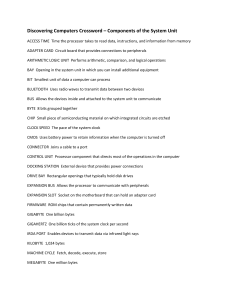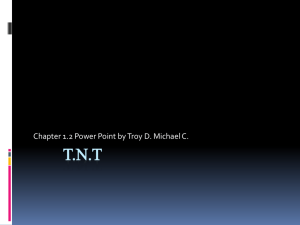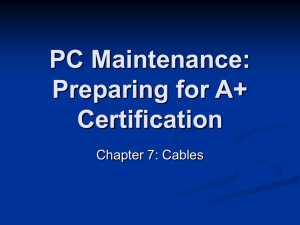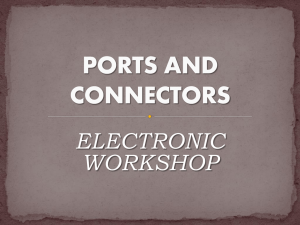Basics
advertisement
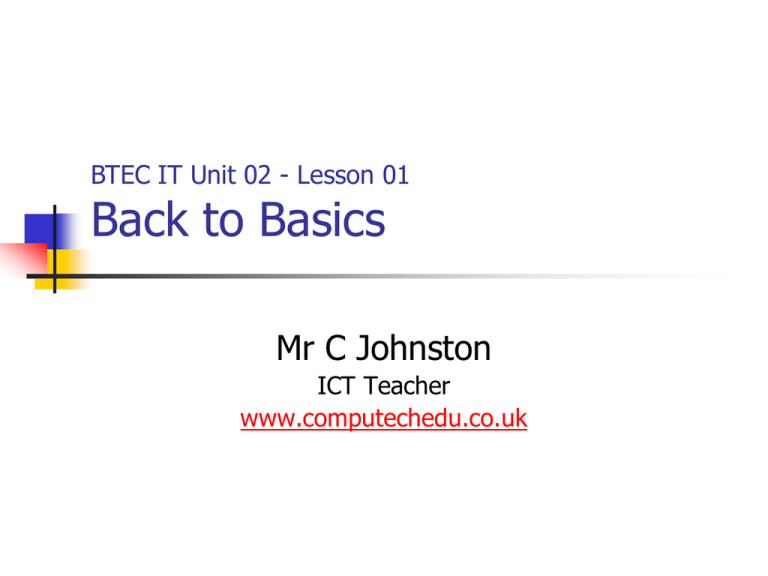
BTEC IT Unit 02 - Lesson 01 Back to Basics Mr C Johnston ICT Teacher www.computechedu.co.uk Session Objectives Understand the difference between input, processing, storage and output devices, Be able to describe the different features of key input and output devices so you can recommend them to others, Know the different types of port on a modern PC and what they are typically used for, Know the different types of cables used to assemble a PC. Starter Download and complete page 1 of the back-to-basics worksheet. Back to Basics Computers operate in bits – electric pulses of either 1s or 0s, How Binary Works Video Computer storage are measured in bytes which are groups of 8 bytes, As computer storage requirements so have the units: KiloByte (KB) – Digital 1000 Bytes/Binary 1024 Bytes MegaByte (MB) – Digital 1,000,000 Bytes/Binary 1,048,576 Bytes GigaByte (GB) – Digital 1,000,000,000 Bytes/Binary 1,073,741,824 Bytes Computer processor speeds are measured in Hz (cycles per second) Basic Requirements INPUT DEVICES PROCESSING STORAGE OUTPUT DEVICES Hardware Requirements Video To Show How A Computer Works System Case Power Supply Mother Board Processor Storage Devices Input Devices Output Devices Types of Port Serial (9 / 25 pin male) – mice + other serial peripherals - obsolete Parallel (25 pin female) – used for old printers - obsolete Games / MIDI Port (15 pin female) – Joy sticks / MIDI devices - obsolete PS2 6pin mini DIN – mouse and keyboard – becoming obsolete USB 1/1.1 (1.5/12 mbps) – original USB port ok for mice and keyboards but little slow for today's devices USB 2 (480 mbps) - used by most devices today – allows high speed data transfer – more popular than FireWire USB 3 (4,000 mbps) – latest faster USB port IEEE 1394 FireWire (400mbps) – very fast port used to transfer data typically for high quality video capture RJ-45 Socket (10/100/1000mbps) – used for network cable connection RJ-11 Socket (56kbps) – used for telephone cable connection HDMI (10.2 gbps) – high definition multimedia interface – transfers video and audio in a single cable in high definition Types of Cable IDE Cable (40pin female) – used to connect HDD and Optical Drives to the motherboard SATA Cable - used to connect modern internal hard disk drives and optical drives to the motherboard Optical Drive Audio Cable – Connects drive to sound card so sound can be heard from it, Serial cable– used to connect devices to serial port Parallel cable – used to connect devices to parallel port USB cable – used to connect devices to USB port – plug is always the same to connect into USB socket but different types fit into devices FireWire Cable – used to connect devices to FireWire port Ethernet Cable – used to connect computers to a network HDMI Cable – used to connect HD video and audio equipment together Topic Exercise Review your answers to page 1 of the back-to-basics worksheet and make any necessary amendments, Complete the input and output device sections of the back-tobasics worksheet.

